Keywords
|
| Internet banking, online banking, E-banking, digital banking, developing countries |
INTRODUCTION
|
| The advent of internet technology has significantly revolutionised the way business and service delivery is carried out by companies and businesses around the world today. Electronic commerce (EC) has transformed the marketing strategies of businesses in the way they sell and deliver their products to the end consumer through the use of the internet. Some of the business activities that have been facilitated through the use of EC include electronic fund transfer (EFT), supply chain management, electronic marketing (EM), online marketing (OM), online transaction processing, electronic data interchange (EDI) and automated data management among others (Zwass, 2003). |
| One area of EC that has been adopted by banks around the world is the phenomenon of internet banking (IB) or online banking. IB has been defined as the use of internet technology in the delivery of banking and financial services using the ubiquitous nature of the internet (George and Gireeshkumar, 2012); and also as the act of performing financial transactions remotely over the internet through a bank’s dedicated website (Shao, 2007). This new service delivery method forms a subset of electronic banking (EB). This encompasses all forms of EB channels including automatic teller machines (ATM), IB, mobile banking (MB), credit and debit card transactions, telephone banking and EFT(Akinci, Aksoy and Atilgan, 2004). With the help of the internet, customers can do their banking transactions at anytime and anywhere as long as internet connectivity is available (Shao, 2007). Akinci et al. (2004) further states that the advent of these new delivery channels has contributed not only to the adoption of multi-channel strategies by the existing institutions, but also the emergence of new forms of financial businesses such as “virtual banks”. |
| IB evolved as one of the primary applications of EC at the turn of the millennium due to the advantages it offers to both financial institutions and the customers. Customers are able to conduct personal and commercial banking activities quickly, efficiently and conveniently through the use of a bank’s internet banking website without leaving the comfort of their home or office hence saving them money on travel cost and time to visit a branch of the bank to make the required transaction. This also provides the bank a way to replicate the same services offered traditionally at bank branches to their online customers at a lower operational cost (Dong and Bliemel, 2008). |
| It is estimated that the operational cost to the bank of performing a transaction on the internet is about $0.01 while the cost of doing the same transaction at a bank branch is estimated to be $1.07 (Sarel and Marmorstein, 2003; Nath, Schrick and Parzinger, 2001). These cost reductions in operational service provision account for the reason why many banks are investing in IB technology while trying to maintain the same service level and satisfaction to their customers. |
| Since the first IB services based on the world wide web (WWW) or the internet were provided by Stanford Federal Credit Union (SFCU) in October 1994 (Zimucha, 2012), IB has spread rapidly in many countries of the world as a result of its convenience and ease in conducting banking activities at anytime and anywhere as long as there is internet connectivity (Auta, 2010). IB has become not just a delivery channel but also a driver for comprehensive industrial change within the banking sector, resulting in the diffusion of IB technology worldwide. |
| The diffusion of IB is the process which IB communicates technology through certain channels over time to members of the banking community and bank users (Rogers, 1995). The diffusion if IB rapidly became one of the main EC applications together with online retail (e-business) and e-services at the start of the 21st century. Despite the benefits that come with this new delivery channel for banking services, many banks and consumers in some least developed and developing countries are yet to adopt and implement IB services (Fonchamnyo, 2013). This is not surprising because humans have always been known to resist change especially if the change will affect their way of working or interacting with each other. This reluctance to change is even greater when it comes to technological changes that will impact company culture and pose other uncertainties such as security risks and trust issues. Rogers (1995) posited that adopters of innovation can be divided into five categories – innovators, early adopters, early majority, late majority and laggards. Many sub-Saharan African countries and Caribbean countries fall within this group of late/slow/non-adopters of IB and classified under late majority and laggards in Rogers’ (1995) categorisation. |
| IB started gaining scholarly attention from the mid to late nineties when banks started implementing information and communication technologies (ICTs) for IB service provision. Previous studies that have been carried out on the research trends in the diffusion of IB from 1998 to 2006, focused on developed countries, notably European countries and North America. Towards the later years (2003 – 2006) research on IB in developing countries, especially those from the Asian bloc started to gain rapid grounds. However, a review of these works has revealed that very little research was being done on IB in African countries. According to Shao (2007) only 3 research articles were uncovered in the trend analysis of IB in African countries while there were no articles found for the South American and the Caribbean countries. |
| The main aim of this research study is to investigate the trends in the adoption of IB in developing countries. This has been done by exploiting the gaps identified in Shao’s (2007) trend study by focusing on research trends for developing countries only. The main objective of this research is to investigate what has been studied on the diffusion and adoption of IB in least developed and developing countries, and to uncover any gaps in the research. The results of this research will provide the current roadmap in the diffusion and adoption of IB research in developing countries, especially those in the African continent. Webster and Watson (2002) stipulated that a methodological review of past literature is crucial for any academic research to help us uncover what is already known in the body of knowledge and where more research attention is needed. The findings will be useful for academics intending to carry out research in this area, and also for practitioners looking to implement or advise banks on the adoption of IB. This work will also help to provide a theoretical and conceptual framework for future research studies in this growing field of study. |
RESEARCH METHODOLOGY
|
| This study focuses on IB research trends in developing countries from 2000 to 2013. This research trend follows the steps in a systems approach to conducting an effective literature review in support of information systems research (Levy and Ellis’s 2006). They proposed a framework that follows the systematic data processing approach that comprises of the following three major stages: inputs (literature gathering and screening); processing (following Bloom’s Taxonomy) and outputs (writing the literature review). This review is therefore systematic-following the above steps; is explicit by explaining the procedures used in conducting the review; is comprehensive in scope by including all relevant material and hence reproducible by others if they follow the same steps in reviewing the topic (Nchise, 2012). |
| A qualitative content analysis of journal research papers on IB in developing countries was conducted to identify categories of factors impacting IB adoption that have been studied, research methodologies that have been used, theoretical frameworks, sampling types, sample population, countries and regions that have been studied and areas that need more scholarly attention. The selection of papers for this study was limited to journal articles because these are peer reviewed, and considered the best medium used by researchers and scholars to share recent and new scholarship on various topics. |
Article Selection Strategy
|
| Although IB just became popular in the late 90’s to warrant scholarly interest, many research studies have been carried out on this topic during this period. Given the overlap between IB and banking as a whole, there are quite a few journals that deal with issues of IB as their main focus. These include the Journal of Internet Banking and Commerce (JIBC) and the International Journal of Bank Marketing (IJBM). Articles for the review were sourced by searching major electronic library databases such as EBSCOHOST, which is the most used online information resource for thousands of universities and institutions around the world with over 50 databases including: Business source Premier, Business source complete, Academic search complete, Computer source and Computer science index. |
| Other databases searched and cross-referenced included: Emerald, ABI-Inform and Google Scholar. These databases have a good coverage of academic research including IB research with more than 6000 journals covering various fields of research and over 200 conference proceedings indexed on EBSCOHOST databases alone. The articles retrieved from the database searches revealed that most of the IB research came from two journals that focus specifically on the issues of IB, banking commerce and bank management - JIBC and IJBM. |
| These two journals were therefore searched thoroughly by looking at each volume and issue from the year 2000 to 2013 to retrieve further articles focusing on IB adoption and diffusion. This resulted in additional articles being uncovered and together with the articles from the databases searches produced a reference library of 369 journal articles. |
| The databases were searched using search keywords that assisted in constricting the search results to articles relevant to our study. The search keywords used were: “internet banking and developing countries”, “e-banking and developing countries”, “electronic banking and developing countries”, “online banking and developing countries”, “digital banking and developing countries”. It was noticed that when “internet banking, online banking or e-banking” were used on their own as a single criteria in the database searches, the number of articles returned were over 4000. Therefore, additional parameters such as “developing countries” were added in the search to ensure that the results returned were relevant to the topic of interest. This drastically reduced the number of articles to a reasonable number on EBSCOHOST for “e-banking and developing countries” showing that the additional parameter was having the desired effect. Also, when “internet banking” was used on its own in the database search on EBSCOHOST, this returned over 13000 articles. However, when “developing countries” was added to the search criteria (“internet banking” & “developing countries”), the results were again drastically reduced to a reasonable number of articles. |
| Three additional delimiters were then added on the articles returned by selecting the year 2000 as the start date for the publications to date. The Full Text checkbox was selected so that the search can only return full text articles and Scholarly (peer reviewed) Journals checkbox to return only academic peer reviewed journals. These delimiters further reduced the number of articles on EBSCOHOST for “e-banking and developing countries” and for “internet banking” & “developing countries”. The same procedure was repeated on the other databases and for each of the keyword combination stated above. It was noticed that using Google Scholar for the searches brought back too many results, in most cases over 100000 even when the search is changed to include developing countries delimiters (“internet banking” & “developing countries”). Google Scholar was therefore limited to backward reference search, backward author search and forward author searches. Using backward and forward author searches is very useful for systematic literature reviews because authors are known to focus their research interests in one field of study and there is a likelihood of finding other articles on the same topic published by them that was not picked up by the database search or that are not indexed on the selected databases used for the initial search (Levy and Ellis, 2006). |
Inclusion Criteria
|
| Initially IB and EB were used interchangeably by researchers to refer to the same concept. However, given that EB is a broader term that embodies other electronic banking channels such as telephone banking, ATM, mobile banking, etc., this study had to include both terms in its search criteria to cover all possible electronic banking research articles and then filter the articles based on the following inclusion criteria: |
| • Peer reviewed research journal articles |
| • Articles whose study population was based on a developing country or emerging economy (classification of developing or emerging economy based on world bank classification 2012) |
| • Articles that focused on IB or online banking |
| • Articles written in English language |
Exclusion Criteria
|
| Articles that were excluded are: |
| • White papers, government reports, periodicals, news reports and sponsored research projects |
| • Conference proceedings |
| • Articles based on mobile banking or other forms of EB |
| • Articles whose study population is in the developed countries (Based on world bank classification 2012) |
| • Articles written in non-English language |
| Studies from developed countries were excluded because this research is aimed at looking at the adoption and implementation of IB in developing and emerging economies. Secondly there has been a lot of research done on the adoption and implementation of IB in the developed countries, and their IB systems are now beyond the adoption stage and more focused on improvements and assessment measures of its benefits. Another reason for excluding developed countries as mentioned earlier is that a trend research on this topic has been done in developed countries-notably Europe and North America (Shao, 2007). Shao’s (2007) paper revealed a big research gap in studies on internet banking adoption in Africa and South America. Hence this study has evaluated the progress that has been made in the developing countries following a methodology similar to the review made by Shao (2007) to unearth areas and countries that need more research attention in the developing and least developed nations. Though there was a sharp rise in studies on IB in the Asian continent in the last 3 years of Shao’s (2007) research, most of these studies were based in a few countries of the Asian region-notably India, Malaysia and Singapore. This review investigates the progress that has been made in the other developing countries in the Asian region and determines any gaps that need further scholarly attention in that region. |
Quality Assessment
|
| All the articles reviewed in this work were scanned through focusing on the abstract, methodology and results to determine if they should be included or excluded using the above inclusion and exclusion criteria. This process identified duplicate articles and many articles that were not addressing the internet or online banking diffusion, adoption and usage. All the resulting articles from the search were also digitally organized by using “authors surnames and year of publication” to avoid duplication when the same article is returned from different searches (Levy and Ellis, 2006). The assessment resulted in a usable library of 188 articles. |
PRESENTATION OF FINDINGS
|
| The 188 articles resulting from the quality assessment were classified following the classification method akin to one used by Nchise (2012) in his review of the trends in edemocracy research. The articles were classified into the following categories: Year of publication, Region, Journal, IS theory used, Research methods, Adoption variables, Sample Types, Population studied and Countries in Africa. A detailed bibliographic list of all articles used in the classification is provided in Appendix 1. |
Classification of Articles by Year Of Publication
|
| Figure 1 shows the classification of articles by year of publication from the year 2000 to 2013. It shows that there was very little research on IB in developing countries in the early part of the 21st century. This can be explained by the fact that IB was a fairly new phenomenon then and was still being adopted in developed countries (Shao, 2007). It also shows that academics interest into research on IB diffusion and adoption in developing countries became more prominent after 2010 and has continued rising since then. The numbers of articles for 2013 are lower compared to the previous 3 years (2010, 2011, and 2012). This can be explained by the natural diffusion curve where research into IB diffusion and adoption is beginning to slow down and giving way to the implementation and improvement phase. Another reason might be due to the fact that this content analysis was carried out during December 2013 when many articles for 2013 had either not been indexed on the various databases used for the search or were published in other databases that were not part of our selected databases. |
Distribution of Articles by Region
|
| It was a bit problematic to divide the various regions of the world when trying to classify which countries fall under the Middle East region and which ones were considered to be within the Asian or African region. For the purpose of this review, Egypt, which is classified as a Middle East country will be considered under African countries based on the continental settings of the world. Also the countries in Eastern Europe have been classified under this review as developing or emerging economies based on the World Bank’s 2012 classification. For the purpose of this review, six regional classifications has been used to represent developing countries and emerging economies of the world – Africa, Asia, Caribbean, Eastern Europe, Middle East and South America. |
| Figure 2 below shows the distribution of research articles by region. It shows that most of the research on IB in developing countries has been carried out in Asia (90 articles, 47.9%). This is closely followed by the Middle East (42 articles, 22.3%), Africa (37 articles, 19.7%), Eastern Europe (17 articles, 9.0%), Caribbean (1 article, 0.5%) and South America (1 article, 0.5%). |
| The surprisingly low percentage of research articles from Eastern Europe may be explained by the fact that this review focused on English Language articles only and most of the countries in Eastern Europe use different languages. The same language barrier can be attributed to the South American region (0.5%), which had just one article in the review. The Caribbean (0.5%) remains a highly under-researched region as well based on this review with just 1 article. Though the Asian region is highly researched, this study still shows most of the research focused on just a sub-section of countries in that region. The review however shows a marked improvement for the African region compared to the data from Shao’s (2007) review where Africa had just 3 articles. This regional classification still reveals a low focus of researchers in the study of IB diffusion and adoption in many developing regions of the world. This can be attributed to a shortage of case study opportunities of banks that have implemented IB hence limiting the research options or other environmental, cultural or socio-economic and political factors that are inhibiting research interest. It will therefore be relevant for Information System (IS) researchers to carry out exploratory studies in these regions especially the Caribbean and South America to determine the factors contributing to this low interest in research studies on IB in these regions. |
Classification of Articles by Journal
|
| This review has revealed that there are so many journals interested in academic research into the diffusion, adoption and usage of IB in the developing and emerging economies. However as shown in Table 1 below, the publishing of research studies on IB is dominated by 2 journals out of the 75 journals returned from our database searches – JIBC (56 articles, 29.8 %) and IJBM (27 articles, 14.4%). By their nature, these journals are focused on IB information technology research in particular and banking research in general. The first edition of the JIBC was published in 1996 when IB was beginning to gain prominence among academics and practitioners. The main aim of the journal was to provide a channel where research and knowledge on this emerging phenomenon could be shared to advance understanding of the technology. Meanwhile the IJBM, which was first published in 1983, focuses on research and innovation in banking hence also providing a good outlet for IB diffusion and adoption research. The increased number of articles from these journals can also be explained by the fact that most researchers in IB submit their research to them for publication as well as the fact that all editions of these two journals were purposively reviewed from the year 2000 to 2013 as part of the article search process as has been explained above. The resultant article library from our database search had 75 journals in total with 60 of them having just 1 article on IB diffusion and adoption in developing countries (classified under others in the table below). |
Classification of Articles by Theories
|
| Findings from this review shows that the majority of the research on IB conducted in developing countries was not based on any theoretical framework (69 % of the articles) as shown in Figure 3. Many of the researchers focused on the adoption and diffusion concept without specifically stating the theory on which their research was grounded. However, among the articles that used a theory to underpin their research, the Technology Acceptance Model (TAM) was the one commonly used with 31 articles (16.5%) of the total number of articles (n=188) reviewed. The other theories used were Diffusion of Innovation (DOI), 5 articles(3%); Decomposed Theory of Planned Behaviour (DTPB), 5 articles(3%); Innovation Diffusion Theory (IDT), 2 articles(1%); Theory of Planned Behaviour (TPB), 5 articles(3%);Theory of Reasoned Action (TRA), 4 articles (2%); Unified Theory of Acceptance and use of Technology (UTAUT), 2 articles(1%); TAM & DOI, 1 article (1%); TAM & DTPB, 1 article(1%); TAM, TRA & TPB, 1 article (1%); and TPB & TAM, 1 article,(1%). A few articles used multiple theories to underpin their research but this was generally limited as revealed by the findings of this review. According to many researchers, TAM is very useful in determining user intentions to use a system and actual use of the system based on the perceived usefulness (PU) and perceived ease of use (PEOU) of the system ( Davis, 1989). |
Article Classification by Research Method
|
| Each article from the included list of 188 articles was coded for the research method used by the researchers in their study. Articles that used survey, content analysis or experimentation (technical implementation) were classified under quantitative research method while articles that used case studies, interviews, focus groups, observations or exploratory studies were classified under qualitative research methods. Articles using a combination of quantitative and qualitative methods were classified under mixed methods. Table 2 below shows the check list used during article classification by research method as adapted from Nchise (2012). It was found that most of the research done on IB adoption in developing countries has been based on quantitative research (171 articles, 91%) while a few have been done through qualitative research (11 articles, 6%) and 6 (3%) articles were found to have used a mixed method approach. The data collection methods used for the quantitative research included questionnaires, surveys and case studies with statistical data analysis; while the qualitative research included face to face interviews, qualitative case studies, observations and focus groups. |
Article Classification by Adoption Variables
|
| The 188 articles were coded for adoption variables used by the various authors to investigate IB adoption. The grouping for the factors impacting IB adoption was intuitively decided by the researchers based on the literature since many authors could refer to the same factor in a different way. For example, adoption variables such as risk, privacy, safety, confidentiality, security and trust were grouped together because they all address issues such as data security faced by customers online. The classification revealed 22 groups of variables that have been regularly investigated by researchers as independent variables impacting adoption of IB in developing countries. As shown in Table 3, the most researched variable identified by the authors that impacts IB adoption and diffusion in developing countries is data security (107 articles, 56.9%). Also due to many authors using TAM as the theoretical underpinning for their research, the investigation of TAM constructs of perceived ease of use (59 articles, 31.4%) and perceived usefulness (50 articles, 26.6%) were also extensively studied. Demographic factors such as age, educational level, gender, income and occupation were also frequently studied (39 articles, 20.7%) as well as computer self-efficacy, internet knowledge and education (35 articles, 18.6%). The percentages and numbers in Table 3 represent the proportion of articles that studied a particular variable since most articles investigated more than one variable. |
Article Classification by Sampling Type
|
| The articles were also coded for the type of sampling used by the researchers in their investigation into IB adoption and diffusion in DC. As shown in Table 4, most of the IB adoption research used non-probability sampling (56.7%) for survey of respondents. This value includes those studies which specifically used common non-probability sampling methods such as researcher judgment (20.2%), Purposive sampling (17%) and convenience sampling (16.5%). Probability sampling (44.7%) was also commonly used with simple random sampling being the most frequently used probability sampling method (39.9%). The classification also revealed that many researchers were using purposive sampling for the qualitative studies. |
Article Classification by Population Studied
|
| Our classification revealed that bank customers (64 articles, 34%) represented the study population frequently used by the authors to investigate IB adoption in developing countries. Researchers also took interest in evaluating IB usage, performance, concerns and accessibility issues by sampling users who have already adopted and registered for IB (37 articles, 19.7%). As shown in Table 5 above, other commonly used population sample included university students and lecturers (9.6%), Banks (9.6%) and bank managers or bank staffs (6.9%). |
| The percentages and article numbers for population studied shown in Table 5 are only indicative measures because some of the studies employed more than one sample type leading to double counting. For example some studies sampled both internet bank users and non-internet bank users to make a comparative analysis of their perception towards IB adoption and usage. |
Article Classification by Countries
|
| The article review revealed that most of the research into IB adoption and implementation has been carried out in India (31 articles, 16.5%) followed closely by Malaysia (20 articles, 10.6%). The number of articles from China were surprisingly low (6 articles, 3.2 %) given the rapid economic growth and the use of ICT in China. This can be explained by the fact that research in china may not have been carried out in the English language hence are not indexed in the databases we searched or published in the two key journals that were individually searched. |
| Given that the research interests of the researchers on this study revolves around ICT diffusion, adoption and implementation in Africa, the articles were further coded for research studies with samples based on countries in the African region. Nigeria emerged as the most researched country from the classification among the African countries represented in the review with 12 articles (6.4%) of the 188 articles reviewed. |
| Figure 4 shows the African countries represented in the review. Cameroon which is the location from which this research study was instigated has just 1 article showing that there is a big gap in research into IB adoption and usage there. Also, the African continent has many countries which are not even represented in the review. This indicates that more research work needs to be carried out in Africa to evaluate the factors affecting the adoption and implementation of IB in the region. The researchers were surprised by the low number of research articles from South Africa (3 articles, 1.6%), which is one of the more advanced emerging economies in the African region. |
| This can be attributed to the fact that many of their research studies might not have been published in journals that were indexed on the databases that were searched as part of this study. |
DISCUSSION
|
| The current trend study is the first to focus entirely on research into IB diffusion and adoption in developing countries. The main aim of the study was to present the current status and rigorousness of IB adoption research in developing countries. This would provide an insight into future research for researchers and academics interested in this area. This work has also justified the need to embark on the study of IB diffusion in Africa in general, and Cameroon in particular where little has been done in this area of research. |
| The result of this review shows an improvement on IB adoption in developing countries, especially African countries compared to the results of the previous trend study carried out by Shao (2007) on IB in the world. The pattern shown in figure 1 for the diffusion of IB in developing countries from the year 2000 to 2013 is consistent with the diffusion of technology curve. It shows a steady growth in the diffusion research peaking in 2012. However, since the review reveals that many developing countries are still underresearched in the area of IB, we expect a continuation of the growth of research articles especially as many of them try to catch up with the developed countries on the IB phenomenon. |
| The classification revealed that internet and computer literacy (just 18.6%) are some of the important factors that affect user acceptance and usage of this new technology. Internet bank awareness (7.4%), infrastructure (9.6%) and accessibility to computers and internet (10.6%) were also seen to be imperative to adoption of IB since many customers in these developing countries lack access to a computer and the internet (Sukkar and Hasan, 2005; George and Gireeshkumar, 2012; Ezeoha, 2005; Agwu, 2012). The classification also showed that many researchers used demographic factors (20.7%) such as age, gender, education and income as well as social norms as study variables. |
| Customer attitude, culture and behavioural control (17%) were also very important factors in IB adoption in developing countries (Sukkar and Hasan, 2005; Boateng and Molla, 2006; Echchabi, 2011). |
| Relative or competitive advantage (9%), risk & security (56.9%), complexity & compatibility (12.8%) were very important factors considered by bank managers when investing into IB technology with risk and security being the most consistent factor studied (Agwu, 2012; Ezeoha, 2006; Akhlaq and Ahmed, 2013; Daud, Mamud and Aziz, 2011; George and Gireeshkumar, 2012). Cost savings (14.4%) and return on investment (9%) were also important factors for implementation of IB by bank management and decision makers who faced the conundrum of non-usage of IB by majority of customers (AbuShanab, Pearson and Setterstrom, 2010; Sarel and Marmorstein, 2004; Boateng and Molla, 2006). |
| The review revealed that most studies were not underpinned by a theoretical framework and the commonly used theories which were adapted and extended by the researchers included TAM (16.5%), DOI (2.7%), DTPB (2.7%), TRA (2.1%) and UTAUT (1.1%) (AbuShanab, Pearson and Setterstrom, 2010; Sukkar and Hasan, 2005; Adesina and Ayo, 2010; Echchabi, 2011). |
| Analysis of the results for the African Continent shows that Nigeria has had a good number of research articles in the area of EB and IB adoption-12 articles (6.4%) of all articles reviewed. Many African countries have no research articles on IB at all and Africa continues to be the highly under-researched continent in the area of information and communication technology and information systems research as a whole (Mbarika and Okoli, 2005). This review therefore justifies the existence of a research gap on the adoption and implementation of IB in many African countries including Cameroon (0.5%) where the researchers are basing their ICT research, which had just 1 article in the review. This research classification also considered the work of Shao (2007) to focus on developing countries only and has shown that more research is needed in the Caribbean, African and South American regions in the area of IB diffusion, adoption and implementation. |
CONCLUSION
|
| This work is one of the first attempts to map the trend in the research on IB or EB in the developing and emerging economies. The main purpose was to give a current picture of research endeavours in the area of IB, expose any gaps in the research and propose future directions into IB adoption and usage research in developing countries. The key findings have shown that most research into IB has been carried out in Asia while the most under-researched regions are South America and the Caribbean. In the African continent, the highest research on IB has been done in Nigeria, followed by Ghana, Mauritius and Tunisia. Results also reveal that research on IB adoption is yet to be done in many African countries. This shows a huge research gap which indicates that more research work has to be carried out in Africa to evaluate the factors affecting the adoption and implementation of IB in the region. |
| Even though all efforts were made during the literature search covering four major databases indexing over 8000 journals in various academic areas, this review cannot be considered exhaustive due to the diverse outlets for publications of research on IB and the continuous increase in journals around the world. Also, the article inclusion criteria focused on peer reviewed journals hence research studies that were published in conference proceedings and other non-academic outlets which could also contribute to the research trends were eliminated from the analyses. However, we are confident that the scope of the library of articles consulted and the findings that have emerged from the analysis is representative of the current research trends on IB in developing countries. |
Tables at a glance
|
 |
 |
 |
 |
 |
| Table 1 |
Table 2 |
Table 3 |
Table 4 |
Table 5 |
|
| |
Figures at a glance
|
 |
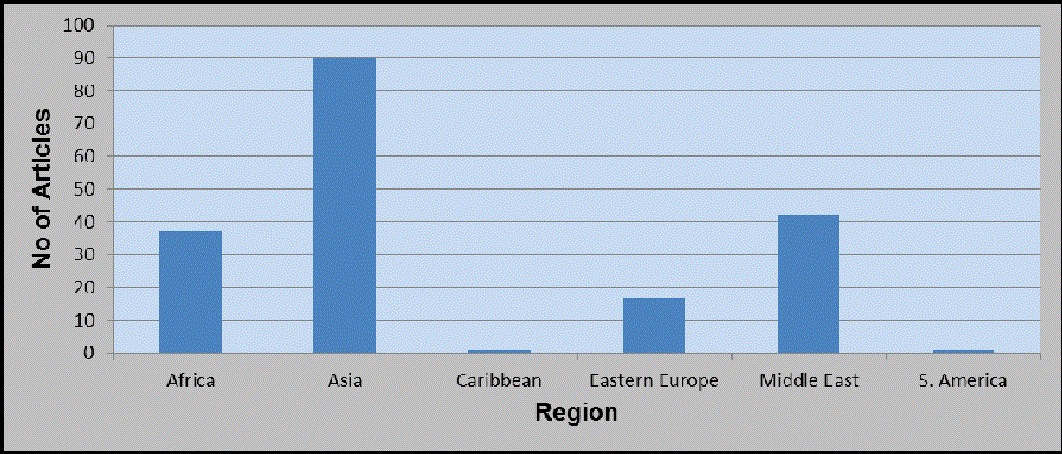 |
 |
 |
| Figure 1 |
Figure 2 |
Figure 3 |
Figure 4 |
|
| |
References
|
- Abbad, M., Abed, J. M., & Abbad, M. (2012).The Development of E-Banking inDeveloping Countries in the Middle East. Journal Of Finance, Accounting &Management, 3(2), 107-123.
- AbuShanab, E., Pearson, J. M., & Setterstrom, A. J. (2010).Communications of theAssociation for Information Systems.
- Adesina, A. A., & Ayo, C. K. (2010).An Empirical Investigation of the Level of Users'Acceptance of E-Banking in Nigeria.Journal Of Internet Banking & Commerce,15(1), 1-13
- Agwu, E. (2012). A Qualitative Study of the Problems and Prospects of Online Bankingin Developing Economies–Case of Nigeria.Journal of Internet Banking andCommerce, 17(3).
- Akhlaq, A., & Ahmed, E. (2013).The effect of motivation on trust in the acceptance ofinternet banking in a low income country. International Journal of BankMarketing, 31(2), 115-125.
- Akinci, S., Aksoy, S., & Atilgan, E. (2004). Adoption of internet banking amongsophisticated consumer segments in an advanced developing country.International Journal of Bank Marketing, 22(3), 212-232.
- Auta, E. M. (2010). E-banking in developing economy: Empirical evidence from Nigeria.Journal of applied quantitative methods, 5(2), 212-222.
- Boateng, R., & Molla, A. (2006).Developing e-Banking capabilities in a Ghanaian ank:Preliminary lessons. Journal of Internet Banking and Commerce, 11(2), 2006-08.
- Daud, N. M., Mamud, N. I., & Aziz, S. A. (2011). Customer's Perception TowardsInformation Security in Internet Banking System in Malaysia. Journal of AppliedSciences Research, 7(9).
- Davis, F. D. (1989). Perceived usefulness, perceived ease of use, and user acceptanceof information technology. MIS Quarterly, 13(3), 319-339.
- Dong, J., & Bliemel, M. (2008).Strategies for Increased Integration of Online and In-Branch Services of Banks in Canada.Journal of Internet Banking and Commerce,13(3).
- Echchabi, A. (2011). Online Banking Prospects in Morocco: An Extension of TechnologyAcceptance Model. Journal of Internet Banking and Commerce, 16(3).
- Ezeoha, A. E. (2006). Regulating Internet Banking in Nigeria: some successprescriptions–part 2.Journal of Internet Banking and Commerce, 11(1).
- Fonchamnyo, D. C. (2013). Customers' Perception of E-banking Adoption in Cameroon:An Empirical Assessment of an Extended TAM. International Journal ofEconomics & Finance, 5(1).
- George, A., & Gireeshkumar, G. S. (2012). Risks in Internet Banking: Sample Evidencefrom Idukki District, Kerala. The IUP Journal of Bank Management, 11(3), 53-63.
- Hsu, C. L., & Lu, H. P. (2004). Why do people play on-line games? An extended TAMwith social influences and flow experience. Information & Management, 41(7),853-868.
- Levy, Y., & Ellis, T. J. (2006).A systems approach to conduct an effective literaturereview in support of information systems research.Informing Science:International Journal of an Emerging Transdiscipline, 9, 181-2
- Mbarika, V. W., Okoli, C., Byrd, T. A., & Datta, P. (2005). The neglected continent of ISresearch: A research agenda for sub-Saharan Africa. Journal of the Associationfor Information Systems, 6(5), 130-170.
- JIBC August 2014, Vol. 19, No.2 - 18 -Nath, R., Schrick, P., & Parzinger, M. (2001).Bankers' perspectives on Internetbanking.E-service Journal, 1(1), 21-36.
- Nchise, A. C. (2012, June). The trend of e-democracy research: summary evidence andimplications. In Proceedings of the 13th Annual International Conference onDigital Government Research (pp. 165-172).ACM.
- Rogers, E. M. (1995). Diffusion of Innovations, Fourth Edition. New York, The FreePress
- Sarel, D., & Marmorstein, H. (2003). Marketing online banking services: the voice of thecustomer. Journal of Financial Services Marketing, 8(2), 106-118.
- Shao, G. (2007). The diffusion of online banking: research trends from 1998 to 2006.Journal of Internet Banking and Commerce, 12(2), 1-13.
- Sukkar, A. A., & Hasan, H. (2005).Toward a model for the acceptance of internet
- banking in developing countries. Information Technology for Development, 11(4),381-398.
- Webster, J., & Watson, R. T. (2002).Analyzing the Past to Prepare for the Future:Writing a Literature Review. MIS Quarterly, Vol. 26, No. 2, pp. xiii-xxiii
- Zimucha, T. (2012). An Evaluation of the Effectiveness of E-banking Security Strategiesin Zimbabwe: A Case Study of Zimbabwean Commercial Banks. Journal ofInternet Banking and Commerce, 17(3).
- Zwass, V. (2003). Electronic commerce and organizational innovation: aspects andopportunities. International Journal of Electronic Commerce, 7, 7-38.
|
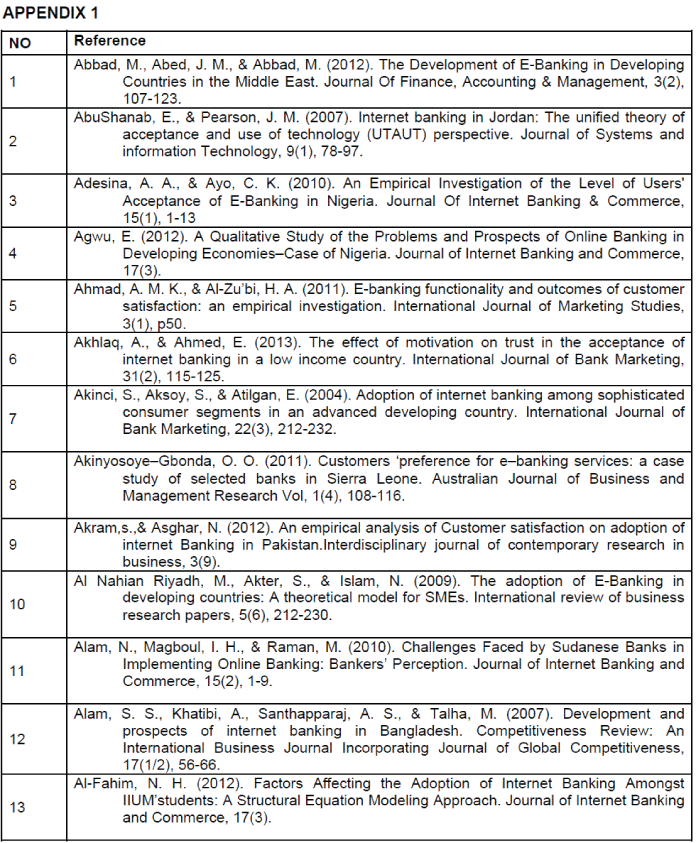 |
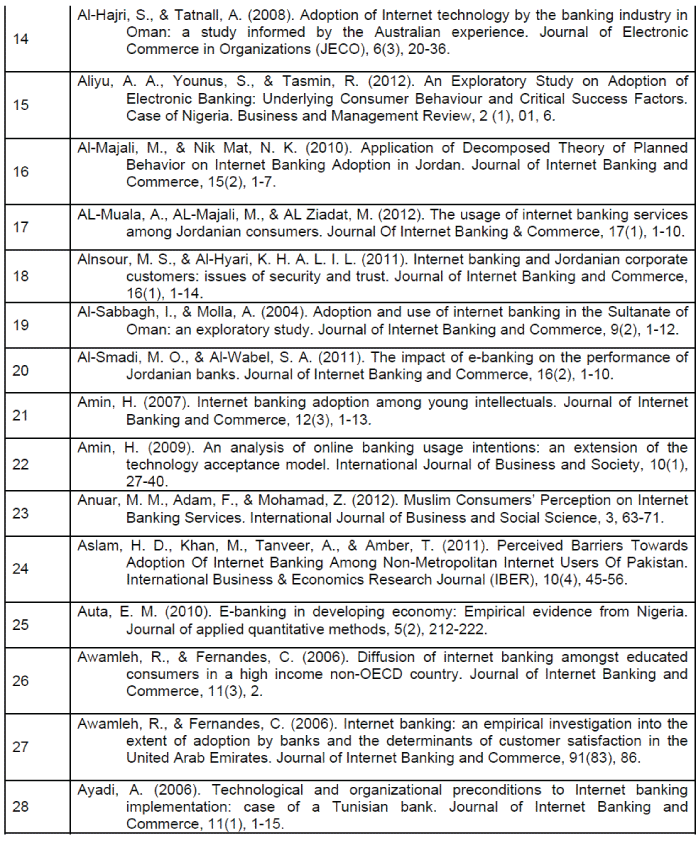 |
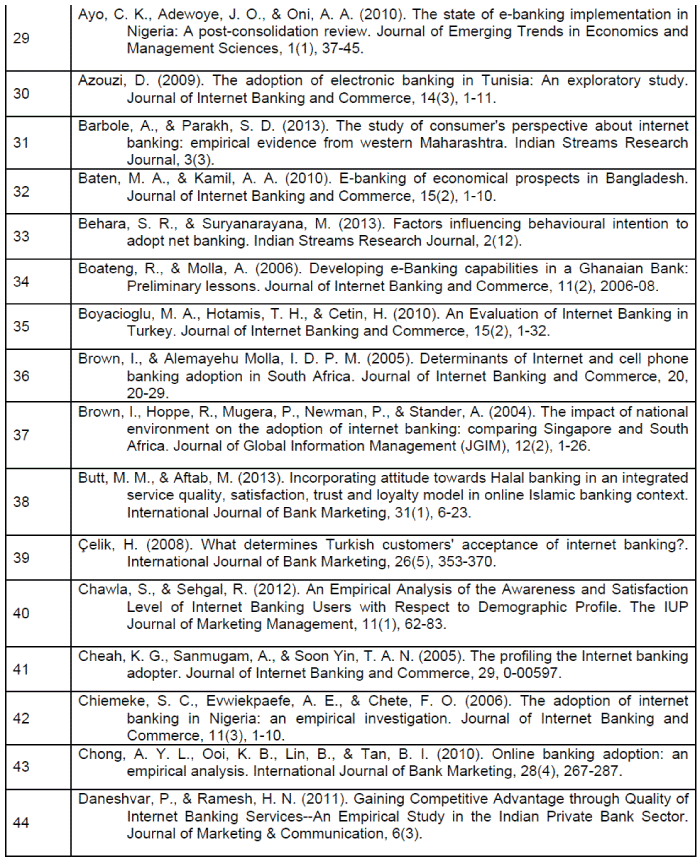 |
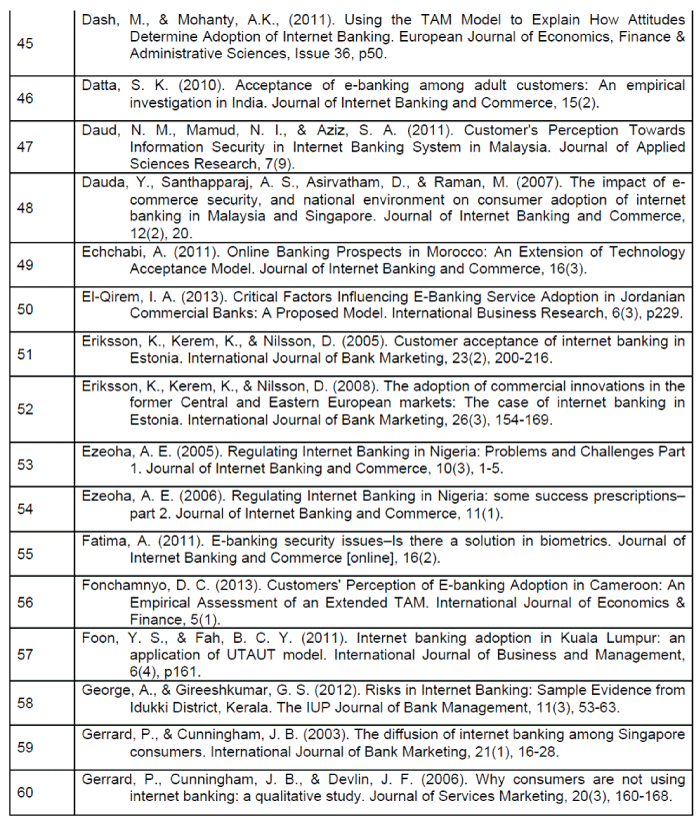 |
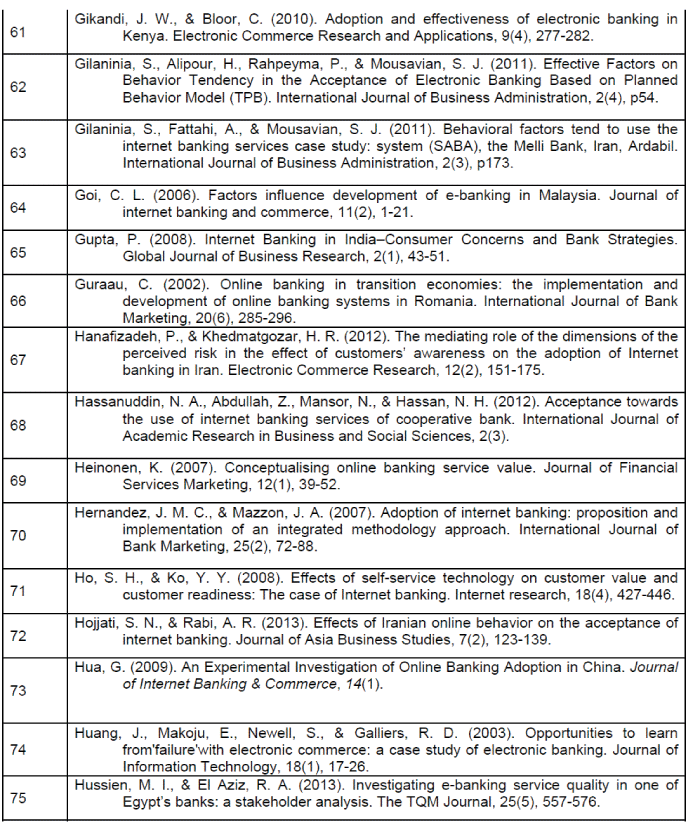 |
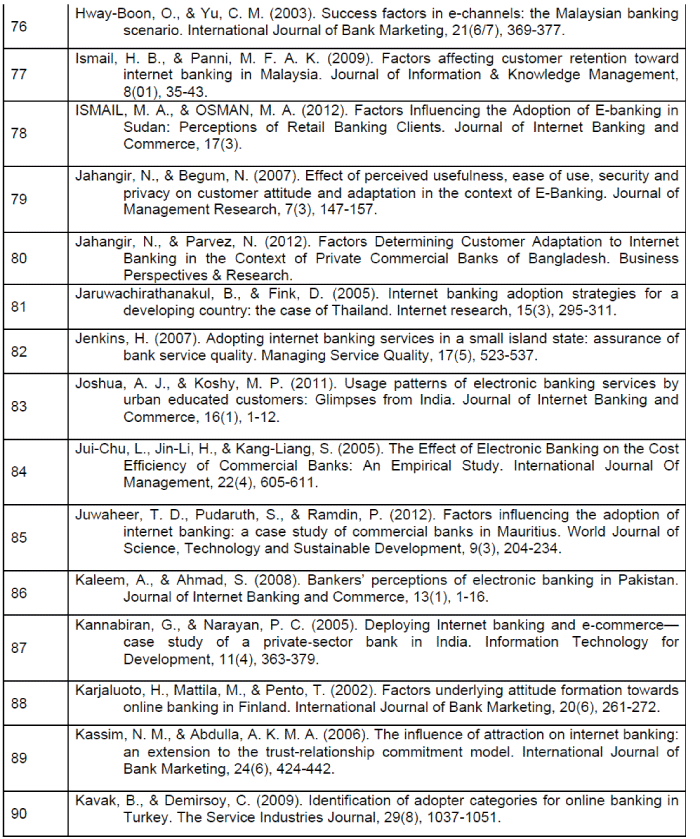 |
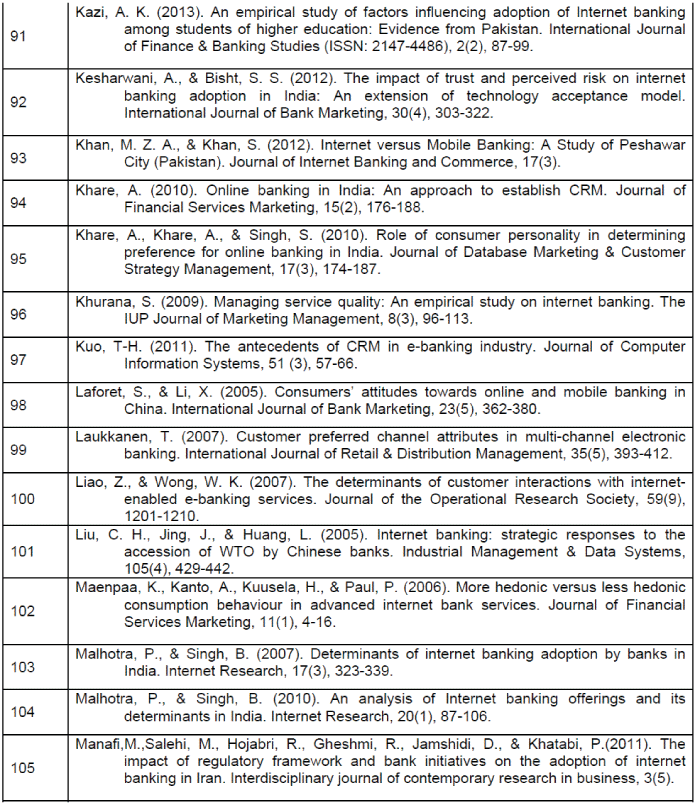 |
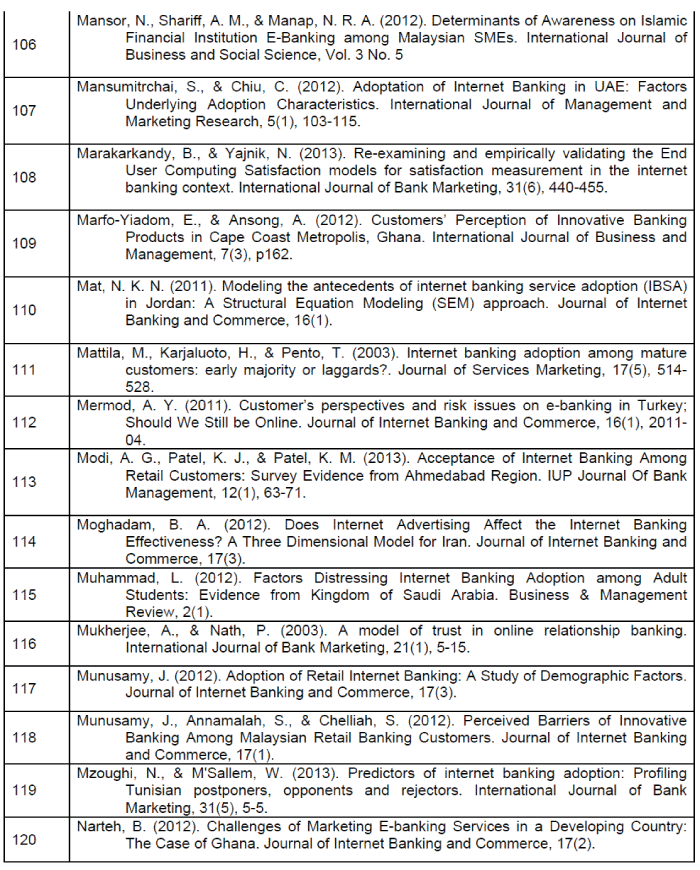 |
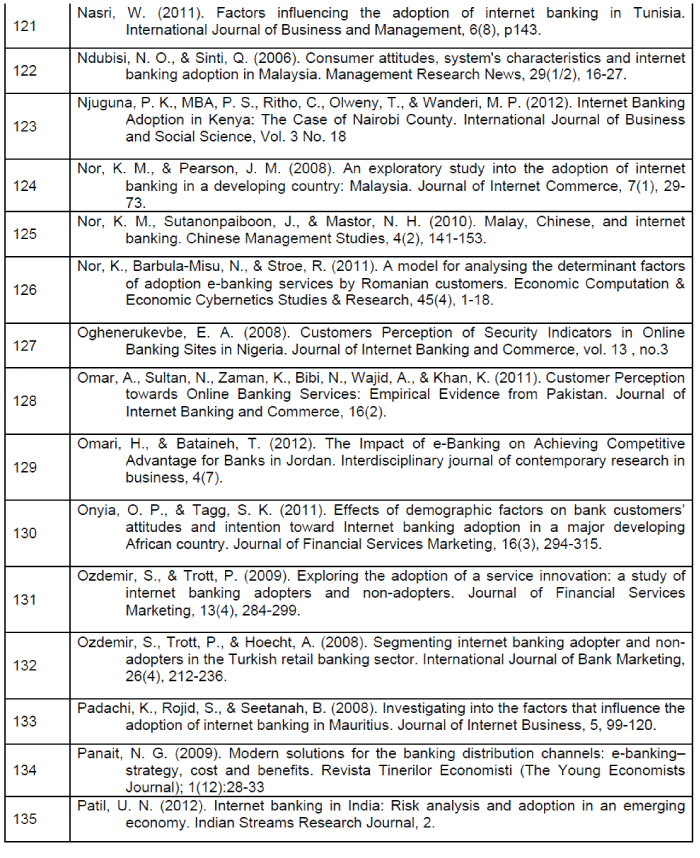 |
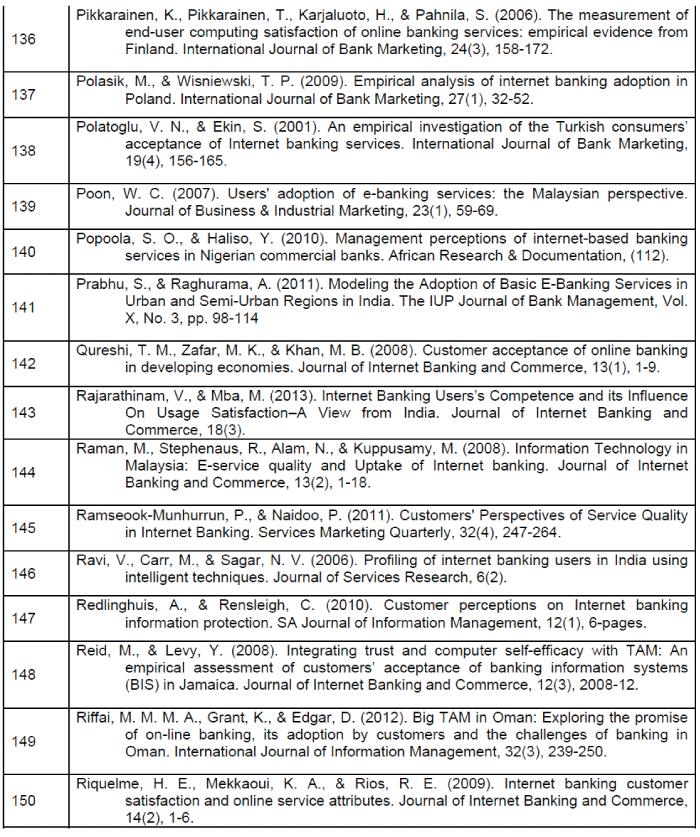 |
 |
 |
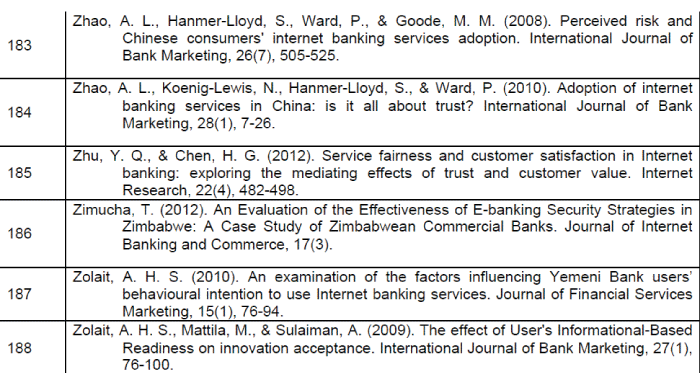 |